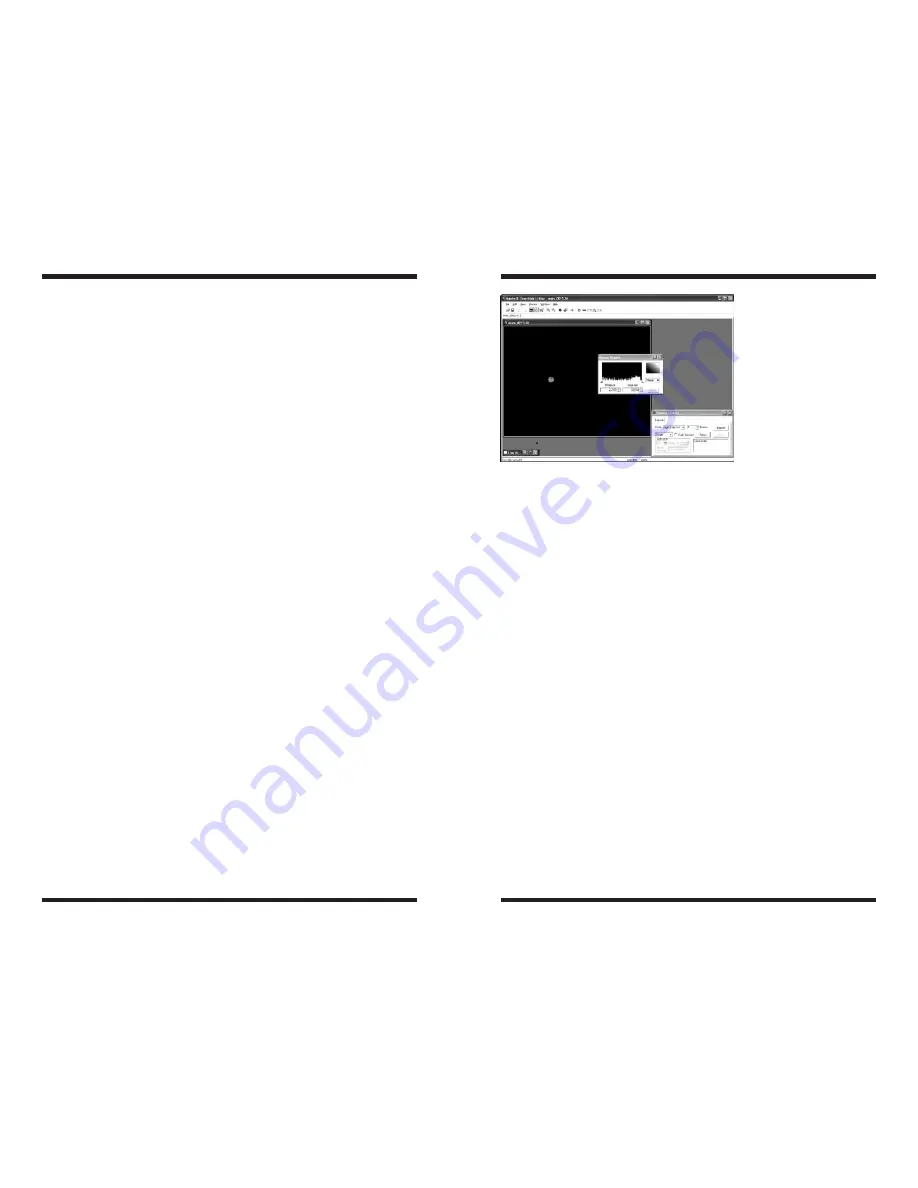
8
9
seeing conditions, wind, or a shaky mount, however, increasing the Frames
to more than 1 will generally decrease image quality. You can take many
individual frames and add them together (“stacking” or “combining”) later,
this will be discussed in detail in the “Astronomical Imaging” section.
11. Select the
Single
beneath the
Mode
box in the
Camera Control
Window
.
12. Keep the
Calibrate
box unchecked in the
Camera Control Window
.
13. Click the
Expose
button in the
Camera Control Window
. An image will
appear in a window.
14. You can save the image for processing later, if you wish. This is done by
selecting
Save
from the
File
menu.
You have now taken your first picture with the SSSSI-III! This simple method
of imaging is exactly how the camera is used to capture terrestrial subjects
during daylight hours. Close-up images of birds and other wildlife or faraway
vistas can all be obtained in this way with the SSSSI-III. Solar images can also
be taken during the day with an optional full-aperture solar filter over the front
of the telescope.
Take some time to use the camera and MaxIm DL Essential software during the
day to become familiar and comfortable with their basic operation. For best
results, you can optimize your images with the camera controls.
Camera Controls
For best images, you can adjust the camera controls though MaxIm DL
Essentials to fine tune the image. You can see how the camera controls affect
an image in the
Live Video Window
.
In the
Camera Control Window
, click the
Setup
button, then choose
Video
Capture Filter
and you can access the camera controls. Here you will find
the
Brightness
,
Contrast
(best at 50% or higher),
Hue
,
Saturation
(level of
color),
Sharpness
(keep this low as it can add noise), and
Exposure
controls.
The
Exposure
control is a gain adjustment that allows additional flexibility in
adjusting image brightness. You can either manually adjust this by unselecting
the
Auto
box and manually moving the slider, or have automatic adjustment
by leaving the
Auto
box selected. For usual operation, the
ColorEnable
box
should remain checked. For black and white camera operation, uncheck this
box. The
Cancel Flicker
button enables and disables the flicker function. The
default has the flicker function disabled, and there should be no reason to use
this function with normal usage of the camera. If the image in the
Live Video
Window
begins to flicker on and off, the flicker function has been mistakenly
enabled; click the
Cancel Flicker
button to cancel this function. To return the
camera controls to their default settings, click the
Default
button.
The other camera controls are available by clicking the
Setup
button, and
selecting
Video Capture Pin
. This accesses the Stream Format property
sheet, which allows you to set additional parameters. The
Frame Rate
, while
generally should be left at 15 frames/second for the sharpest planetary images,
can be toggled down to 7.5 frames/second for brightest exposures. (You can
also use the
Video Capture Filter
selection described previously to adjust
image brightness.) Check the
Flip Horizontal
box to change the orientation of
the image display in the
Live Video Window
.
Color Space / Compression
selects the codec used by the camera; in this case it is RGB 24. The Output
Size can be used to shrink the image size if desired; the camera defaults to
640x480, but you should raise this to the highest setting (1280 x 1024) for the
maximum possible resolution. The other parameters shown with the
Video
Capture Pin
selection cannot be adjusted.
Try several different settings to get a feel of how the camera controls work
and affect the resultant image on the computer screen. The
Brightness
and
Exposure
controls are the ones you will use the most. The telescope being
used, seeing conditions, and object being imaged will dictate how these cam-
era controls should be set. Usually Exposure will be set first, then Brightness
is adjusted as needed.
Screen Stretch Window
The function of the
Screen Stretch Window
(Figure 6) is to properly map the
image brightness levels captured by the camera into corresponding image
brightness levels on the computer screen. A typical camera image has each
pixel (light detecting site, over 1,300,000 pixels form a single SSSSI-III image)
represented as a number depending on brightness. This has to be mapped
into the video monitor’s brightness range. It is important to set the screen
stretch appropriately, or a great image may look terrible!
Figure 6.
The settings in
the
Screen Stretch Window
greatly determine how an
image will appear on your
computer screen.















